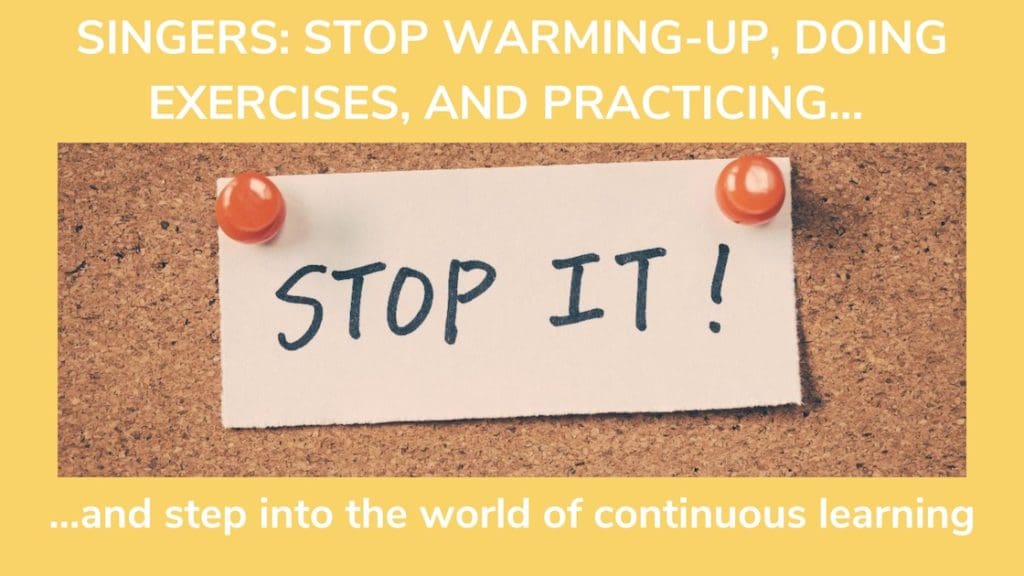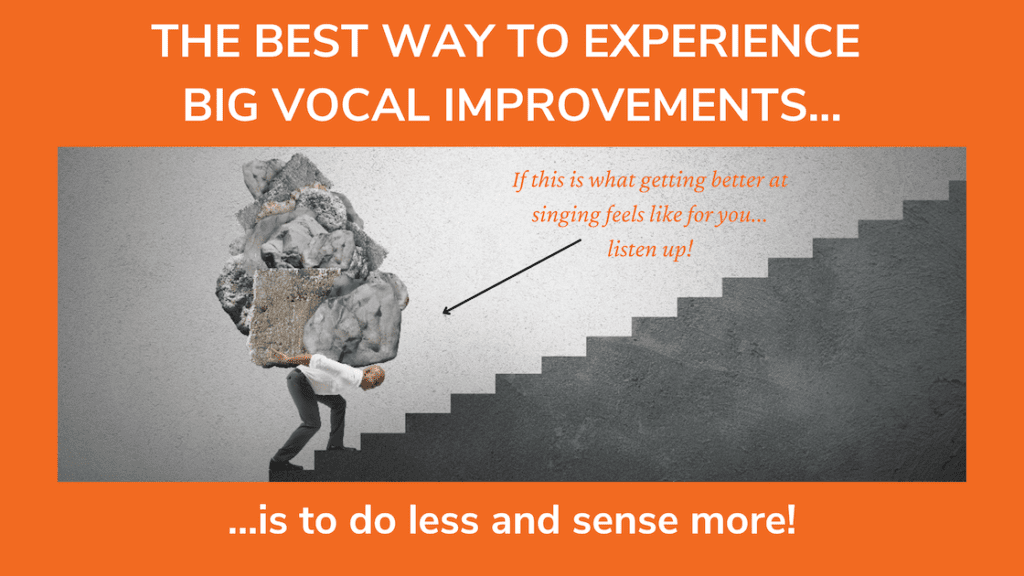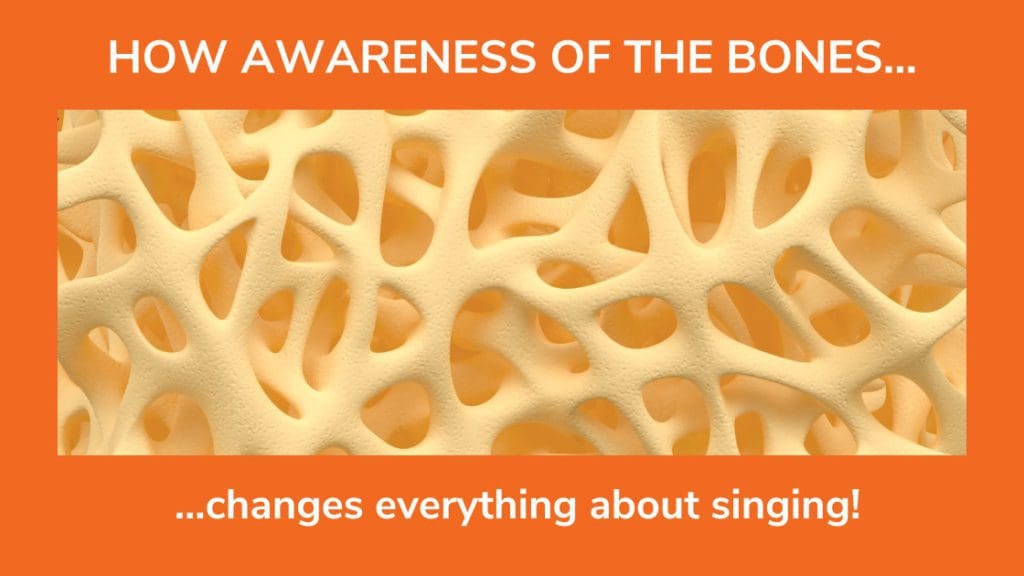Inside This Article
What is Vocal Learning?: Three Blogs, Three Perspectives
In the realm of genuine vocal learning, our focus shifts away from traditional practices that often involve extensive warm-ups, strenuous exercises, and repetitive routines.
Instead, the emphasis lies on finesse and nuance rather than sheer endurance or strength, process and engagement rather than rote practice and protocols, sensations and awareness rather than goals or results, rest and integration rather than compulsion or performance.
Each of the following blogs that I’ve written since 2021 addresses a unique aspect of the paradigm shift from exercise to learning, from teaching to facilitation.
“Singers, Stop It!” advocates for foregoing elaborate warm-ups and placing trust in one’s current abilities. It encourages a playful approach to singing, emphasizing exploration and a readiness for surprises.
Sensory awareness becomes paramount, enhancing the singing and learning experience and multiplying the results through engaging awareness itself.
The central message is that improvement in singing is an ongoing journey, not contingent on rigid routines. Sometimes, awareness is enough to create change!
“The Best Way to Experience Vocal Improvements” introduces the Weber-Fechner Principle, which underscores the value of doing less while heightening sensory awareness.
This principle, likened to adjusting the weight of a backpack, highlights that reducing stimulus can lead to heightened sensitivity and perception of subtle changes, resulting in more significant vocal improvements. It’s the awareness that endures. Facilitating that awareness is the learning itself.
It’s the awareness that endures. Facilitating that awareness is the learning itself.
Robert Sussuma
In “Understanding Vocal Support,” the focus shifts to the concept of “support” in singing, with a specific emphasis on skeletal support.
This goes beyond breath support, delving into the intricate interplay between bones, muscles, movement, proprioception and self-organization. The belief in the sufficiency of bones for efficient support, as advocated by Dr. Moshe Feldenkrais, is central. This approach minimizes the need for excessive muscle engagement, leading to a sense of lightness and ease in singing and speaking.
When the skeleton is liberated to be the primary lender of support, a new world of ease and functionality opens up in all other systems!
Collectively, these blogs challenge the entrenched belief that vocal progress hinges solely on rigorous warm-ups and repetitive exercises. Instead, the blogs advocate for a sensory-driven, intuitive and relational approach.
Through the principles of doing less, sensing more, and trusting in the innate capabilities of the body/mind/self, vocal learners are invited to embark on a path of continuous growth and improvement through awareness and development.
These articles herald a transformative shift in how vocal mastery is understood and pursued, hopefully, ushering in an era of nuanced and skillful learning in the field of voice.
SINGERS, STOP IT!: 5 Atlernatives to Compulsive Warming-up, Endless Exercises to “FIX” Problems that Don’t Exist and Repetitive Mindless Practicing!

This blog challenges traditional singing practices, advocating for alternatives to warming up, excessive exercises, and repetitive practicing. The argument presented is that these approaches may hinder progress rather than facilitate it. Singing is portrayed as a skill of finesse and nuance, not a test of endurance or strength. The conditioning effects of warming up, exercises, and practicing are critiqued, suggesting that they may create negative habits and limitations. Instead, the blog proposes five alternatives:
1. Just Sing: Encourages singers to dive right into singing without extensive warm-ups, advocating for trust in one’s current abilities.
2. Play: Suggests embracing a playful approach to singing, trying new things, and being open to surprises.
3. Explore Variations: Recommends experimenting with variations each time you sing to keep things fresh and prevent rigid habits.
4. Engage in Sensory Awareness: Emphasizes the importance of being attuned to bodily sensations and interoception, which exponentially enhances singing and learning.
5. Keep Singing/Learning: Underscores the value of consistent playful engagement and learning, emphasizing that improvement in singing is a continuous journey as awareness begets more awareness.
The ultimate encouragement is for singers to let their voices emerge naturally and to trust in their own development without being overly fixated on conventional and ultimately limiting practices.
Read the full article: Singers, Stop it!
The Best Way to Experience BIG Vocal Improvements: DO LESS, SENSE MORE!

This blog challenges the common belief that more effort leads to better results in singing. It introduces the Weber-Fechner Principle, which states that reducing stimulus increases sensitivity and the ability to perceive small changes.
Applying this principle to singing, it suggests that doing less can lead to more significant vocal improvements because when we do less we can sense more and when we sense more we are able to perceive and work with the nuances of what we are doing in more sensitive and effective ways.
An analogy of carrying a backpack is provided to illustrate the principle: adding one pound to a heavy load goes unnoticed, but adding one pound to a lighter load is perceptible. Similarly, reducing the complexity of vocal exercises can lead to increased awareness of vocal nuances and improvements in technique.
The article recommends singing songs on a single note to focus on specific aspects like text, tone, and rhythm. By doing so, singers can refine their technique and become more attuned to their vocal folds’ condition. There is also encouragement to explore various vocal qualities and dynamics on a single note, opening up new possibilities for expression.
The key takeaway is that doing less, but with heightened sensory awareness, can lead to significant vocal improvements almost automatically. Singers are advised to go slower, lighter, and softer, reduce extraneous variables, rest more, and stay within their comfort zone while exploring new possibilities. By embracing this approach, singers can achieve notable changes in their vocal abilities while truly enjoying the learning process.
doing less, but with heightened sensory awareness, can lead to significant vocal improvements almost automatically
Robert Sussuma
Read the full article: The Best Way to Experience Big Vocal Improvements: Do Less, Sense More!
Understanding Vocal Support – The BARE BONES of Singing

This blog article explores the concept of support in singing, focusing specifically on skeletal support. It emphasizes that understanding support goes beyond just breath support, delving into the intricate relationship between bones, muscles, movement, proprioception and awareness.
Dr. Moshe Feldenkrais’s belief that bones are capable of supporting the body efficiently when used in relation to gravity with awareness is highlighted. This minimizes the need for muscles to hold up the skeleton, allowing them to be available for fluid and coordinated movement. It is explained that the bones transmit the force of gravity, while the muscles facilitate movement. When the nervous system makes this shift in organization, the entire system improves in its functionality.
The blog discusses a Feldenkrais lesson called “Rapping the Heels,” which involves bouncing on the heels to sense the reverberations through the skeleton. This lesson aims to help individuals experience a sense of lightness and floating, akin to being in water – where the skeleton was developed in the first place, evolutionarily. The suggestion is made that organizing oneself skeletally leads to a profound sense of ease and freedom in breathing, moving, singing and speaking.
Ultimately, there is an advocacy for a deeper exploration of skeletal support as a crucial element in vocal training. This enables a natural and expressive connection between breath, tone, intention, and movement.
Read the full article: Understanding Vocal Support – The Bare Bones of Singing
Vocal Learning and Mastery, a Comprehensive Approach
These three articles collectively challenge many of the conventional approaches to vocal learning.
They share a common theme of advocating for alternative, more intuitive methods that prioritize nuanced skill development over excessive effort, awareness over superimposition. The encouragement is for singers to trust their current abilities, embrace a playful attitude towards singing, and explore variations to keep their practice dynamic.
In “The Best Way to Experience Vocal Improvements,” the Weber-Fechner Principle is introduced, emphasizing the value of doing less while heightening sensory awareness. This approach allows singers to perceive subtle changes and make meaningful progress. Singers are encouraged to focus on specific aspects like text, tone, and rhythm, ultimately leading to improved technique.
In “Understanding Vocal Support,” the focus shifts to the concept of skeletal support, highlighting how bones play a crucial role in efficient movement and action. The promotion of the idea that bones, when utilized by the nervous system in relation to gravity with awareness, can provide substantial support to the body, reducing the need for excessive muscle engagement. This approach leads to a sense of lightness and ease in all functions, but especially in singing and speaking.
Collectively, these blogs challenge the notion that vocal improvement is solely achieved through rigorous warm-ups, exercises, and repetitive practice. Instead, singers are encouraged to adopt a more sensitive, intuitive, system-respective, sensory-driven approach. By embracing the principles of doing less, sensing more, and trusting in the innate capabilities of the body/mind/self, singers can embark on a journey of continuous growth and improvement in their vocal abilities.
Read these articles next to begin re-imagining vocal mastery through a series focused on going from tradition to transformation in vocal learning:
Singers: Are you sick of vocal warm-ups, endless exercises and quick-fixes that don’t last? Are you practicing and practicing and still not getting better in the ways you want? Well, the good news is you can stop. No, really… STOP IT! None of it is actually helping you and I’ll tell you why. And not only will I do that, but I’ll tell you what to do instead. But, don’t just take my word for it, experience it for yourself!
THE BEST WAY TO EXPERIENCE BIG VOCAL IMPROVEMENTS: DO LESS, SENSE MORE!:
We think it’s best to do more all the time: sing more, practice more, exercise more, etc. in order to get better. But, that just isn’t the case! Here’s another way to get more by doing less…
UNDERSTANDING VOCAL SUPPORT – THE BARE BONES OF SINGING
We talk a lot about support in singing and usually about breath support, but there’s more, much more to this idea of support that has more to do with the skeleton than anything else. Learning to support one’s self and one’s singing skeletally changes everything.





0 Comments